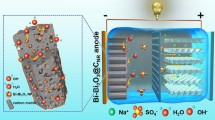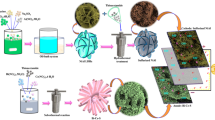Abstract
Bismuth oxide (Bi2O3) has received great attention as an anode material for alkaline nickel/bismuth (Ni/Bi) batteries due to its high theoretical capacity and easy preparation. However, the generally poor conductivity of metal oxides and the instability of Bi2O3 during cycling severely limit the device performance. Herein, we present the use of directly grown Bi2O3 nanoflake film with kinetic advantages as the anode for Ni/Bi batteries. Particularly, glucose-derived carbon is integrated onto the surfaces of nanoflakes, which not only enhances the electron transfer but also buffers the conversion-reaction induced volume expansion of Bi2O3, helping maintaining the cycling stability of the film. The resulting Bi2O3@C electrode exhibits high specific capacity, excellent rate performance (can be charged within 6.7 s), and good cycle stability (∼1,200 times; fading rate of only 0.011% per cycle). When assembled with a nickel oxide (NiO) nanosheet array cathode in basic electrolyte, a fully binder-free Ni/Bi battery is obtained, which delivers maximum energy and power densities of 34.29 W h kg−1 and 12,159.8 W kg−1, respectively, and good cycling performance. The power density is even much superior to that of many hybrid/asymmetric supercapacitors. Our work suggests a new generation of thin-film Ni/Bi batteries for potential high-power electronic applications.
摘要
氧化铋(Bi2O3)作为碱性镍/铋电池的负极材料, 因其理论容量高、 易制备而受到广泛关注. 然而, 金属氧化物普遍较差的导电性以及氧化铋的循环不稳定性严重限制了器件的性能. 本文用直接生长的具有动力学优势的氧化铋纳米片薄膜作为镍/铋电池的负极; 同时将葡萄糖衍生的碳包覆在纳米片的表面, 不仅促进了电子传递, 还缓冲了氧化铋转换反应过程中的体积膨胀, 有助于维持电极的循环稳定性.该Bi2O3@C电极表现出高比容量, 优异的倍率性能(在6.7 s内充满电)以及良好的循环稳定性(约1200次; 每圈仅衰减0.011%). 与氧化镍(NiO)纳米片阵列正极搭配, 组装的完全无粘结剂的碱性镍/铋电池展现出34.29 W h kg−1的最大能量密度和12159.8 W kg−1的最大功率密度以及良好的循环性能; 其功率密度甚至远远优于许多混合/非对称型超级电容器. 本研究展现了新一代薄膜镍/铋电池在高功率电子器件应用上的巨大潜力.
Similar content being viewed by others
References
Cheng F, Liang J, Tao Z, et al. Functional materials for rechargeable batteries. Adv Mater, 2011, 23: 1695–1715
Gong M, Li Y, Zhang H, et al. Ultrafast high-capacity NiZn battery with NiAlCo-layered double hydroxide. Energy Environ Sci, 2014, 7: 2025
Zhang K, Hu Z, Tao Z, et al. Inorganic & organic materials for rechargeable Li batteries with multi-electron reaction. Sci China Mater, 2014, 57: 42–58
An C, Liu X, Gao Z, et al. Filling and unfilling carbon capsules with transition metal oxide nanoparticles for Li-ion hybrid supercapacitors: towards hundred grade energy density. Sci China Mater, 2017, 60: 217–227
Xu D, Mu C, Wang B, et al. Fabrication of multifunctional carbon encapsulated Ni@NiO nanocomposites for oxygen reduction, oxygen evolution and lithium-ion battery anode materials. Sci China Mater, 2017, 60: 947–954
Wang G, Fu L, Zhao N, et al. An aqueous rechargeable lithium battery with good cycling performance. Angew Chem Int Ed, 2007, 46: 295–297
Qu Q, Fu L, Zhan X, et al. Porous LiMn2O4 as cathode material with high power and excellent cycling for aqueous rechargeable lithium batteries. Energy Environ Sci, 2011, 4: 3985
Zeng Y, Lin Z, Wang Z, et al. In situ activation of 3D porous Bi/ carbon architectures: toward high-energy and stable nickel-bismuth batteries. Adv Mater, 2018, 30: 1707290
Ke X, Zhang Z, Cheng Y, et al. Ni(OH)2 nanoflakes supported on 3D hierarchically nanoporous gold/Ni foam as superior electrodes for supercapacitors. Sci China Mater, 2017, 61: 353–362
Xia Y, Yang Y, Shao H. Differences in the effects of Co and CoO on the performance of Ni(OH)2 electrode in Ni/MH power battery. J Power Sources, 2011, 196: 495–503
Wang H, Liang Y, Gong M, et al. An ultrafast nickel–iron battery from strongly coupled inorganic nanoparticle/nanocarbon hybrid materials. Nat Commun, 2012, 3: 917
Yang B, Yang Z, Wang R. Facile synthesis of novel two-dimensional silver-coated layered double hydroxide nanosheets as advanced anode material for Ni–Zn secondary batteries. J Power Sources, 2014, 251: 14–19
Ahlberg E, Palmqvist U, Simic N, et al. Capacity loss in Ni–Cd pocket plate batteries. The origin of the second voltage plateau. J Power Sources, 2000, 85: 245–253
Sarma B, Jurovitzki AL, Smith YR, et al. Redox-induced enhancement in interfacial capacitance of the titania nanotube/bismuth oxide composite electrode. ACS Appl Mater Interfaces, 2013, 5: 1688–1697
Gujar TP, Shinde VR, Lokhande CD, et al. Electrosynthesis of Bi2O3 thin films and their use in electrochemical supercapacitors. J Power Sources, 2006, 161: 1479–1485
Wang HW, Hu ZA, Chang YQ, et al. Facile solvothermal synthesis of a graphene nanosheet–bismuth oxide composite and its electrochemical characteristics. Electrochim Acta, 2010, 55: 8974–8980
Yuan D, Zeng J, Kristian N, et al. Bi2O3 deposited on highly ordered mesoporous carbon for supercapacitors. Electrochem Commun, 2009, 11: 313–317
Senthilkumar ST, Selvan RK, Ulaganathan M, et al. Fabrication of Bi2O3 AC asymmetric supercapacitor with redox additive aqueous electrolyte and its improved electrochemical performances. Electrochim Acta, 2014, 115: 518–524
Zeng Y, Lin Z, Meng Y, et al. Flexible ultrafast aqueous rechargeable Ni Bi battery based on highly durable single-crystalline bismuth nanostructured anode. Adv Mater, 2016, 28: 9188–9195
Sun J, Li Z, Wang J, et al. Ni/Bi battery based on Ni(OH)2 nanoparticles/ graphene sheets and Bi2O3 rods/graphene sheets with high performance. J Alloys Compd, 2015, 643: 231–238
Sun J, Wang J, Li Z, et al. Assembly and electrochemical properties of novel alkaline rechargeable Ni/Bi battery using Ni(OH)2 and (BiO)4CO3(OH)2 microspheres as electrode materials. J Power Sources, 2015, 274: 1070–1075
Yuan P. Electrode behaviors of BiFeO3 powders: a possible application of Bi2O3 oxide in rechargeable battery. Int J Electrochem Sci, 2017, 12: 3686–3696
Liu J, Jiang J, Cheng C, et al. Co3O4 nanowire@MnO2 ultrathin nanosheet core/shell arrays: a new class of high-performance pseudocapacitive materials. Adv Mater, 2011, 23: 2076–2081
de Jong M, Meijerink A, Gordon RA, et al. Is Bi2+ responsible for the red-orange emission of bismuth-doped SrB4O7? J Phys Chem C, 2014, 118: 9696–9705
Peng M, Wondraczek L. Photoluminescence of Sr2P2O7:Bi2+ as a red phosphor for additive light generation. Opt Lett, 2010, 35: 2544–2546
Huang Y, Li Y, Hu Z, et al. A carbon modified MnO2 nanosheet array as a stable high-capacitance supercapacitor electrode. J Mater Chem A, 2013, 1: 9809
Zuo W, Xu P, Li Y, et al. Direct growth of bismuth film as anode for aqueous rechargeable batteries in LiOH, NaOH and KOH electrolytes. Nanomaterials, 2015, 5: 1756–1765
Zuo W, Zhu W, Zhao D, et al. Bismuth oxide: a versatile highcapacity electrode material for rechargeable aqueous metal-ion batteries. Energy Environ Sci, 2016, 9: 2881–2891
Zhao Z, Ye Y, Zhu W, et al. Bismuth oxide nanoflake@carbon film: A free-standing battery-type electrode for aqueous sodium ion hybrid supercapacitors. Chin Chem Lett, 2018, 29: 629–632
Qu D, Wang L, Zheng D, et al. An asymmetric supercapacitor with highly dispersed nano-Bi2O3 and active carbon electrodes. J Power Sources, 2014, 269: 129–135
Ci S, Wen Z, Qian Y, et al. NiO-microflower formed by nanowireweaving nanosheets with interconnected Ni-network decoration as supercapacitor electrode. Sci Rep, 2015, 5: 11919
Zhang Y, Wang J, Wei H, et al. Hydrothermal synthesis of hierarchical mesoporous NiO nanourchins and their supercapacitor application. Mater Lett, 2016, 162: 67–70
Xiao H, Qu F, Wu X. Ultrathin NiO nanoflakes electrode materials for supercapacitors. Appl Surf Sci, 2016, 360: 8–13
Liu J, Chen M, Zhang L, et al. A flexible alkaline rechargeable Ni/ Fe battery based on graphene foam/carbon nanotubes hybrid film. Nano Lett, 2014, 14: 7180–7187
Simon P, Gogotsi Y. Materials for electrochemical capacitors. Nat Mater, 2008, 7: 845–854
Christen T, Carlen MW. Theory of Ragone plots. J Power Sources, 2000, 91: 210–216
Xu H, Hu X, Yang H, et al. Flexible asymmetric micro-supercapacitors based on Bi2O3 and MnO2 nanoflowers: larger areal mass promises higher energy density. Adv Energy Mater, 2015, 5: 1401882
Wang X, Li G, Chen Z, et al. High-performance supercapacitors based on nanocomposites of Nb2O5 nanocrystals and carbon nanotubes. Adv Energy Mater, 2011, 1: 1089–1093
Aravindan V, Chuiling W, Reddy MV, et al. Carbon coated nano- LiTi2(PO4)3 electrodes for non-aqueous hybrid supercapacitors. Phys Chem Chem Phys, 2012, 14: 5808–5814
Wang Q, Wen Z, Li J. A hybrid supercapacitor fabricated with a carbon nanotube cathode and a TiO2–B nanowire anode. Adv Funct Mater, 2006, 16: 2141–2146
Acknowledgements
This work was supported by grants from the National Natural Science Foundation of China (51672205), the National Key R&D Program of China (2016YFA0202602) and the Research Start- Up Fund from Wuhan University of Technology.
Author information
Authors and Affiliations
Corresponding authors
Additional information
Deliang Ba received his BE degree in electronic science and technology from Beijing University of Technology in 2016. He is now studying for his Master’s degree at Huazhong University of Science & Technology. His research interest focuses on the preparation and modification of electrode materials for sodium ion batteries, aqueous batteries and supercapacitors.
Yuanyuan Li received her MSc and PhD degrees in Department of Physics, Central China Normal University, China. She has been a faculty at the School of Optical and Electronic Information, Huazhong University of Science and Technology, China since April, 2010 and is now an Associate Professor. Her research interests include the synthesis of semiconducting metal oxide nanostructures and their applications in electrochemical energy storage (supercapacitors & batteries) and solar water splitting.
Zaiping Guo received her PhD in Materials Engineering from the University of Wollongong in December 2003. After APD fellowship in the Institute for Superconducting & Electronic Materials, she joined the Faculty of Engineering and Information Sciences, University of Wollongong as a Lecturer in 2008, and was promoted to Professor in 2012, and then Senior Professor in 2013. Her current research interests focus on the design and application of nanomaterials for energy storage and conversion, including rechargeable batteries, hydrogen storage, and fuel cells.
Jinping Liu received his PhD degree from Central China Normal University (CCNU) in June 2009. During the period of 2008–2011, he did visiting and post-doctoral research at Nanyang Technological University (NTU) in Singapore. He is currently Chair Professor at Wuhan University of Technology. The research interests in Dr. Liu’s group include the nanostructures synthesis and their electrochemical applications (batteries, supercapacitors & electrocatalysis).
Rights and permissions
About this article
Cite this article
Ba, D., Li, Y., Sun, Y. et al. Directly grown nanostructured electrodes for high-power and high-stability alkaline nickel/bismuth batteries. Sci. China Mater. 62, 487–496 (2019). https://doi.org/10.1007/s40843-018-9326-y
Received:
Accepted:
Published:
Issue Date:
DOI: https://doi.org/10.1007/s40843-018-9326-y




